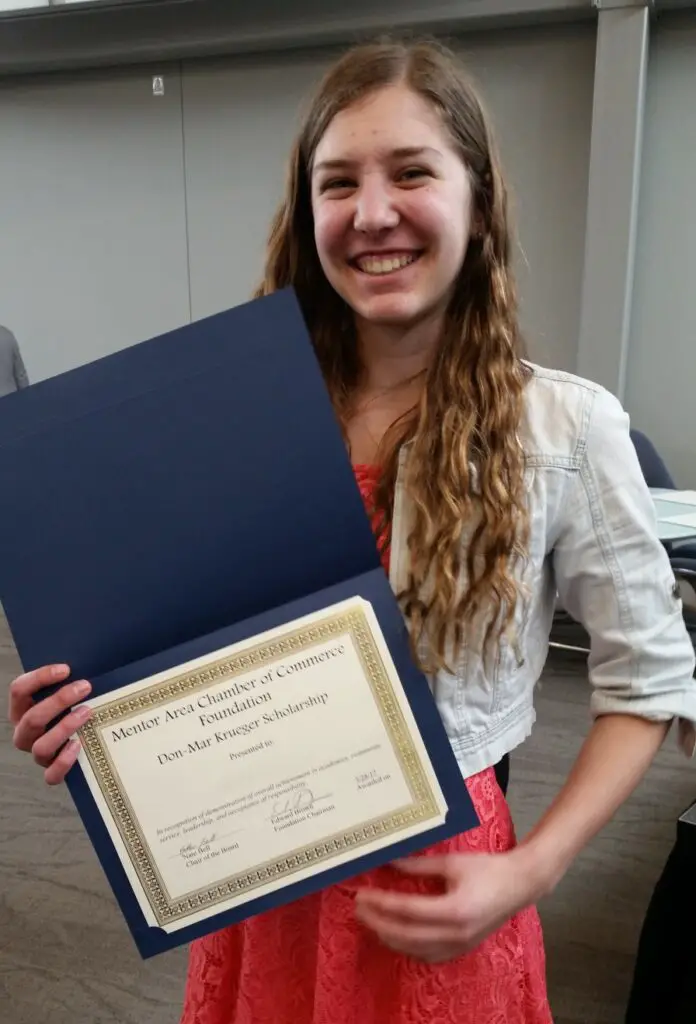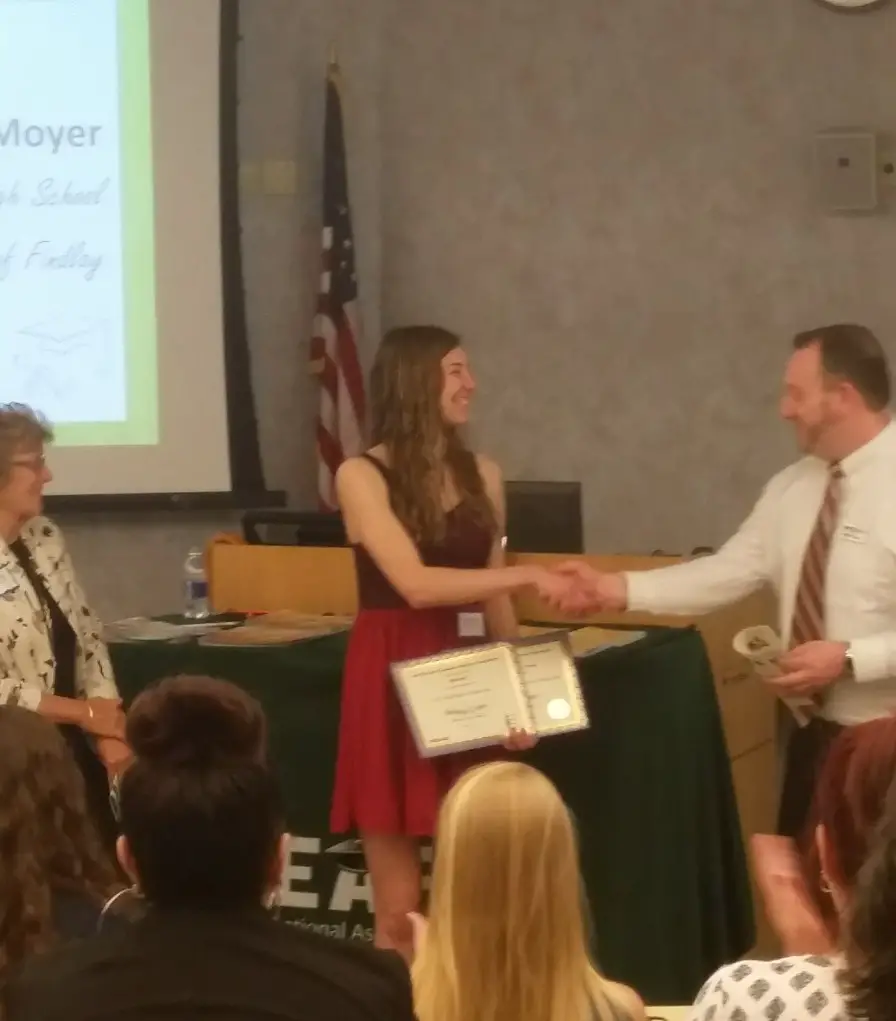DISCLOSURE: If I link to relevant products or helpful info it may be an affiliate link, meaning I may earn a small commission. As an Amazon Associate & other affiliate, I earn from qualifying purchases at no extra charge to you. The views & opinions are my own. Please see the disclaimer and privacy policy.
Last Updated on November 9, 2025
If you are reading this in your senior year and you haven’t started, you had better start working triple time! Getting ready for scholarship applications should begin as soon as you enter high school, working all throughout your high school years and culminating as the grand recipient of many awards at the end of your senior year.
Applying for scholarships takes years of preparation, with the final senior year being a massive sprint of work to the bitter end.

When my youngest daughter graduated, earning 10 outside scholarships, she had earned enough to have her first year completely paid off! Even with all these wins, she still did not prepare early enough. Some of the larger scholarship deadlines are early in the senior year. It wasn’t until the new year rolled over that her activities list and essays began to come together to make a perfect application packet. You can NEVER start too early. Here are some of my notes after much learning as I went through the experience as the parent of senior high school students.



Prep Work for Award-winning Scholarship Applications
Preparation for scholarship applications begins the moment you set foot in high school. Every activity is an entry on those scholarship applications. Remember, you are possibly competing against tens of thousands of other students with a massive activity list. Make sure you are not eliminated in round one and include every activity that you have been a part of, no matter how big or small. It is up to the scholarship committee to decide the weight of each activity
Make a spreadsheet for your scholarship applications:
You will need to know exactly when you joined every group, when you quit each group, how many hours per day, per week, per month you participated in that group. Making this list as you journey through high school will make your application job in your senior year a little easier.
Make a huge spreadsheet and enter each activity. Organize it with the most important or the most hours at the top. You will need sections for school activities, outside non-school activities (hobbies), volunteer activities, employment, and awards. Sometimes these categories cross over each other, but your ultimate goal on each application will be to make sure to include every entry on your spreadsheet somewhere on your scholarship application. Entries for each activity should include start date (some applications require exact dates, and some require grades so make a column for each), end date, amount of time for participation (each application will have a different way that they require it expressed, so you can enter this in hrs/week and weeks/year in order to make it easier for yourself), leadership position, awards earned for each activity and a short description of each entry.


Include Youth Activities on your scholarship application:
Have you been a member of a youth activity that you are now outgrowing? Consider sticking it out for one more year so that you can use that activity on your applications. My daughter was a member in a girl scout troop since kindergarten. Their troop had mostly disintegrated, and the activities that they participated in had dwindled down to a summer camping trip and a few volunteer activities throughout the year. I advised her to wait another year before parting ways with the Girls Scouts of Northeast Ohio. She was a loyal member and finished up her service in her freshman year. Some applications require you to enter what year you participated, some do not and the sheer volume and quality of activities are what matters. Even better, some applications do not indicate that only high school activities matter, in that case, my daughter’s years of participation for girl scouts increased from just grade 9 to ten whole years of her life! Impressive!

Summers count when filling out a scholarship application:
The summer after you graduate 8th grade, you are now a high schooler, and all your activities count. Sign up for volunteer work in the summer when you have extra time.
Essays for a scholarship application
Summer is a good time to lay the groundwork for all your essays. You can use your college entrance essay as your main go-to essay. This should be an essay about what makes you unique. This is the most widely used essay and should be the one that is reviewed and edited the most. Have your parents, friends, and many teachers review this essay. Take all their comments seriously and then combine them into one grand masterpiece.
Revise it again over the numerous submissions. Make sure that you keep each version (with a label in the title indicating what important change you made). There will be times when an older version of the essay fits the prompt more closely. Don’t get me wrong. You are not going to be able to submit the exact same essay for each application, but the main body can sometimes be similar, with revised introductions and conclusions that will pertain directly to the prompt and the scholarship that you are applying to.

Parent and Teacher Review:
The most common comments that I gave my daughter were “Expand on this” and “Give me an example.” Parents can’t write the essays, but they can certainly give advice. If they aren’t moved by the essay (and believe me, parents are quite biased and it doesn’t take much!), then you certainly aren’t going to evoke any emotions in your application reviewer. Make that a goal. You want the reviewer to remember you after he puts down your application, and one way to do this is to use emotions in your essays. Happiness, sadness, or triumph over an obstacle! Find something that is unique in your life that the reader will connect with and remember after he is done reading through 1,000 applications.

Word limits:
Word limits are your friend and your enemy. The best essays are the ones with a large word count limit. When you start your essay plan on 200-300 words for a good quality paragraph. Most applications have a limit in this range. Start long since it is much easier to cut out words than to add them. If you end up being 200 words over the limit, you need to eliminate an entire idea and condense your essay. Keep a list of the major points you need to include in your essay and cut everything out except for that.
Types of essays:
Language essays and Character essays are the two types of essays that scholarship applications could require. My daughter hated writing essays, so she only participated in the applications that required character essays. These essays are not graded so much on the grammar, but on the quality of the ideas that you are expressing. These essays want to know WHO you are and why they should choose you. Language essays are assessing your intelligence of grammar and your discussion and knowledge of the topic. Make sure you gear your responses appropriately.

Character Essay prompts
These essays are varied according to the type of organization that is awarding the scholarship, there are definitely common recurring questions. Work on these essays and you will have a solid base when applications start rolling in.
Why should we choose you for this scholarship?
This essay should be a version of your “I am Unique” main essay. You should begin and end it with edited sections pertaining to the individual scholarship. Each scholarship is unique and is intended to fund a certain type of student. Find out what type of student they are looking for by reading their summary and purpose statements, and tell them why you fit that mold and therefore, that is why they should choose you.
What are your career goals?
This question has various versions. Most often, they are searching for what you plan to do with your life, how you plan to get there, and why you chose this path. The answer to this essay depends on your word limit. For long essays make sure you include why you chose your college, what you plan to study there, and how this relates to your career. Sometimes, there is even more room to write, and you should add how your career will benefit society or the specific audience of the scholarship committee. For example for the City Chamber of Commerce Scholarship application, my daughter wrote about how her business would directly benefit the city. If you are undecided about your future, you can say this, but think of a career path that may interest you and explain why you would like to find out more information about it. You aren’t choosing your life-long career in stone, and your scholarship committee will not mind if you suddenly switch career paths when you enroll in your freshman year.
What is your greatest weakness?
Unfortunately, there were a couple of applications that had this question. Hopefully, there will be a large word limit for you. This way you can explain your weakness and then tell the committee how you hope to overcome or tackle this weakness. Is it time management? Tell them you will conquer this weakness in college by being a devoted day-planner user. Is your weakness shyness? Tell them you will enroll in public speaking in college to overcome your fear. Pick a weakness that is manageable and a weakness that you feel the committee can relate to. If you had a traumatic event in your life, this is the place to explain that and tell them how you overcame that.
What activity has had the most impact on your life?
Choose the activity from your spreadsheet list that you can say the most about and that you have been the most involved in, and discuss all the important points at length. Another version of this question is the most important person in your life. A good twist on this is to choose the advisor or leader of your most important activity. This way, you will be able to use most of the same activity essay with a new beginning and end.
The most important thing to know about the essays is that they are trying to find out what type of person you are. Listing all your activities one after the other can be impressive at first, but adding a personal story in a well-written essay gives the scholarship committee a look into your character.
Interview for a Scholarship
Many scholarships have interviews in addition to the prepared application. Make sure that you make a copy of your application before you send it in because this is where they will formulate a lot of their questions. Know your application inside and out as well as the answers to the most common interview questions.
Are you ready to prepare for your college scholarship interview?
Click the link so that you have the foundation you need to succeed. I have prepared a list of the most common interview questions for you. PLUS you will also have the BONUS opportunity to schedule a free practice interview so that you will be prepared.
FREE FREE FREE FREE FREE
Important things to know when applying for a college scholarship
Junior Year is the most important:
In her last year of high school, my daughter’s first scholarship application was due October 3rd. That was barely into her senior year. In fact, all the major full-tuition and > $10,000 scholarships were due in the fall. The only grades, activities, and test scores that were submitted on these major scholarship applications were up until junior year. Point taken? Don’t slack off in your junior year!
It doesn’t matter. Take both and figure out which one you like better and then re-take it until you like your score. All of your scores will be on your official transcript that you send to the committee, but most of them also have an entry line for you to enter your best score. In this case, it really doesn’t matter how many times you have taken that test. Make sure you make this decision based on the colleges that you are applying to!
References and recommendations:
You need an inventory of recommendations from two teachers and two community members (pastor, girl scout leader, supervisor, volunteer activity coordinator…). You will need to use different references for different submission requirements, so have at least this many references in your file and ready to go. You want to choose your references carefully. They should know you in and out of the classroom or activity where they met you. They will need to attest to your intelligence, work ethic, character, and chance of success in your chosen field. Choose someone that will do a good job bragging about you. Give them a copy of your final activities list and a copy of your main character essay so that they can include some of those items in their letter.
Also, give them PLENTY of time to get started. Give them at least 2 weeks to compose and edit their letter before the first submission is due. They should be willing to let you read a copy of the reference that they are providing. If not, you might want to choose someone else. Go ahead and read their recommendation and make sure it fits you. A good reference will be willing to add or delete comments that do not fit with who you are, so make sure it paints a perfect picture of the best YOU.
Stay Organized:
My daughter applied for 39 scholarships. There were a lot more out there, but there was no way that she could have applied for more than that. Each application is long and involved. Yes, the activities list and essays are written ahead of time, but they still need to be edited and formatted differently for each application. Make a spreadsheet. List all the scholarships that are available and organize them by the due date. Work on them in that order so that you do not miss any deadlines. Mark them off after you turn them in, and mark them when you hear a response from the scholarship committee.

Neatness and professionalism:
For each scholarship application, you will receive an instruction sheet and a paper copy of the application (although some applications will be online, there are many that are still on paper). These should be organized in a file by the due date. If you did not receive a pdf version of the application you will need to convert the paper copy to a fillable pdf form. This is accomplished with a scanner and Adobe Acrobat programs. Applications should be neatly typed on the pdf form (my daughter had only one application that was required to be hand-written).
Save everything! Save the blank form in case you need to go back and save each version of the form as you fill it out. Once you are done, print out your completed form and proofread it one final time before sending it in. Don’t forget to mark it as submitted on your master scholarship list.
Courtesy:
Finally, once you start receiving notifications from the scholarship committees, keep track of those. Many of them will require a submission of your senior picture so that they can add you to their powerpoint presentation. You will need to go to their presentations to receive your certificate and thank them. Keep their paperwork so that you can send them a thank you note! Congratulations on all of your hard work! Pass on your tips of success to your underclassmen so that they too can win!




This is such great advice. I’m done with this with my girls as they are past school years and both have their degrees already but I do remember the preparation that is needed to get scholarships. You need to put in the time in your Junior year and I’m glad you spoke about that in your article.